When I reviewed Cadillac's then-new large sedan last year, my #1 reason "why not to buy" an XTS was powertrain performance. The 304-horsepower V6 (shared with the related Buick LaCrosse and Chevrolet Impala) felt fairly energetic above 4,500 rpm, but the typical buyer of a large luxury sedan doesn't desire to wind an engine out. This buyer wants effortless acceleration, and the 3.6 lacked sufficient torque to deliver it. Tall gearing further hobbled the peaky V6. Never fear, for 2014 the XTS can be purchased with a pair of turbos that bump horsepower from 305 to 410. Of greater relevance for how these cars are typically driven, torque swells from 264 lb-ft (at 5,200 rpm) to 369 (at a much more accessible 1,900 rpm).
This additional power could be just what the Cadillac XTS needs to take on...what? Last yearI compared the regular XTS to an Audi A6. But now a new Cadillac CTS has arrived to take on the midsize Audi. The A8 is much closer to the XTS in length (if not width). But with an aluminum body and sophisticated chassis designed from a clean sheet for flagship duty (no VW bones here), the big Audi is in a different class, and costs about $20,000 more. Meanwhile, the Cadillac's recently refeshed crosstown competitor, the Ford-based Lincoln MKS, isn't quite in the same class as the XTS and, reflecting this, costs about $10,000 less.
Assuming none of the people pricing these cars has completely lost touch with reality, the big Cadillac is a close match for neither the Audi nor the Lincoln. The XTS must be significantly better than the MKS, but not nearly as good as the A8. But are the price differences fully warranted? Will potential buyers perceive the Cadillac as easily worth $10,000 more than the Lincoln, yet as a smart way to save $20,000 (assuming they have it) versus the Audi?
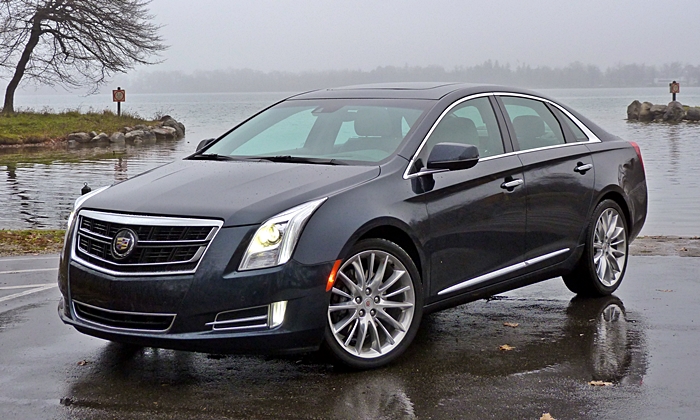
Dramatic stance enhanced by 20-inch wheels. more XTS photos
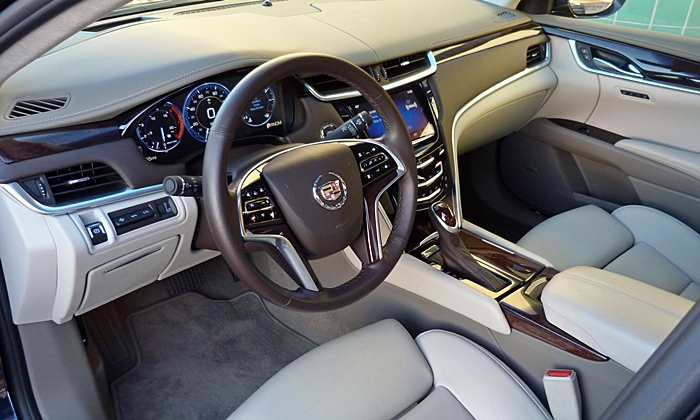
A lot going on, much of it covered in leather. Also available with dark gray seats.
| |
Compared to the MKS |
| Interior styling |
 Better
Worse
Better
Worse
|
A glance inside the Cadillac XTS readily dispatches any thought that it's just a tarted-up Chevrolet Impala. Soft leather, contrasting stitching, a band of top quality timber, thick chrome trim, piano black control panels, and two large, vivid liquid-crystal displays combine to deliver a visual tour de force. The aesthetic is too forceful, and the curves too few, to have the warmth of an Infiniti or neo-classic Jag. But, true to the Cadillac tradition, there's more visual drama here than in typical German fare. Insufficiently subtle for your taste? Then get an Audi.
It doesn't hurt that the XTS's interior materials are perhaps the best yet seen inside a domestic car. Anything that looks like it could be luxuriously padded is. The wood and metal are the real deal. Most fits are tight and precise, even the complicated area where the multi-layered instrument panel runs into the door. (The wide-gapped storage compartment lids are exceptions.) In the tested XTS Vsport Platinum, upgraded leather covers the instrument panel and upper door panels as well as the seats; Alcantara (an expensive faux suede) graces those parts of the ceiling that aren't glass; and the wood trim gains dark inlays. You can't get this much leather inside an A8 without stepping up to the V8-powered, extended wheelbase L 4.0T, and that car's Full Leather and Luxury packages cost nearly $10,000. In this context, the Platinum's $2,580 bump over a similarly equipped XTS Premium seems a bargain.
Even with an update for 2013, the interior of the archrival Lincoln MKS appears drab and dated, even fusty, in comparison. The Lincoln's instrument cluster, the same analog speedometer flanked by a pair of small LCDs previously seen in half the Ford lineup, doesn't appear nearly as upscale or as sophisticated as the fully reconfigurable single-panel cluster in the XTS. You'll also find real wood inside the MKS, but it's so shiny and artlessly integrated (bulging out from the door panels and swelling around the base of the shifter) that even a Lincoln salesperson thought it was fake. Revising this wood would go a long way towards getting this interior where it needs to be. The hides covering the seats are already there. They feel at least as soft and rich to the touch as those inside the Cadillac.
The tested Audi A8 I wasn't heavily optioned, and so didn't have as lavish an interior as the XTS Vsport Platinum. The short, angled center stack packs a sportier vibe than you'll find in the domestics, though, and the appearance of the instrument panel suggests serious, highly precise engineering. Welcome to your wood- and faux suede-trimmed flight deck. Yet some of the switches are surprisingly clicky for a $80,000+ car.
| Exterior styling |
 Better
Worse
Better
Worse
|
It doesn't matter how appealing a car's interior is if its exterior is so boring (or worse) that few people care to peer inside. Well, the exterior of the XTS certainly isn't boring. We've got a tall, blunt nose; a high beltline; a long tail topped by a short deck thanks to C-pillars that just won't quit; and, at night, LEDs highlighting the corners. With such odd proportions, the XTS isn't beautiful by conventional standards. Yet I'm intrigued, and find the car oddly attractive despite an inescapable feeling that I should not. These cars are all over metro Detroit, yet even on the thousandth viewing the XTS catches my eye. Kudos to GM's designers for making such challenging proportions work.
Less arguably, the XTS has presence. It stands out. No one will mistake it for a Chevrolet, or anything else for that matter. The ATS and new CTS, toned down to suit international tastes, should be as distinctive and dramatic.
The Lincoln's proportions stray from convention with the car's almost crossover-like 61.6-inch height (two over the already tall Cadillac). With 3.5 inches more length (205.6 vs. 202.0) overhanging a slightly longer wheelbase, the Lincoln also has more visual mass in its tail and snout. These massive overhangs combine with an unusually high beltline to make the MKS's wheelbase appear much shorter than its 112.9 inches (vs. the Cadillac's 111.7). Back when the MKS was new I found the resulting proportions somewhat interesting, but not to nearly the same degress as those of the much edgier XTS. Today the car's exterior, like its interior, appears relatively dated and downscale. And no one seems to be a fan of the baleen grille.
And the Audi? The A8's a handsome car, but--aside from the over-sized grille that inspired an industry-wide trend--far more understated than the XTS. (The Cadillac might only be considered understated compared to its definition-of-flamboyant forebears.) At a glance the A8 even can be mistaken for the two-sizes-smaller A4. The big Audi relies on sheer size (underscored by a massive prow) to convey its station.
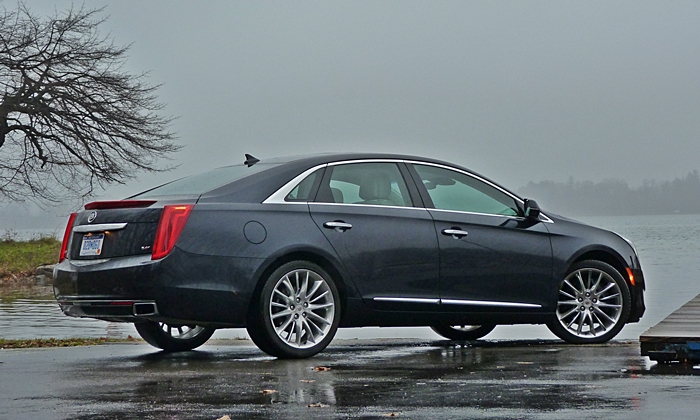
Long sweeping roofline extends nearly to vertical tail lamps that recall the fins of the '50s.
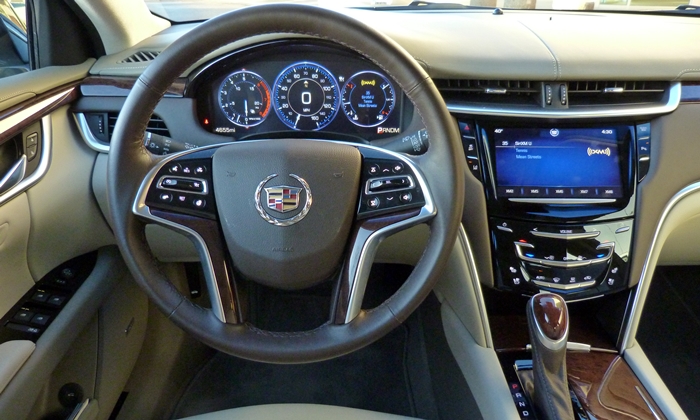
Beautiful displays and control panels, but could be easier to use.
| Powertrain performance |
 Better
Worse
Better
Worse
|
Owing to the big bump in power, the XTS Vsport is quick. The turbos shave the time to 60 mph by two seconds, to just over five. But don't let the 410-horsepower rating fool you. In magazine tests, the 365-horsepower Lincoln MKS and (allegedly) 333-horsepower Audi A8 are just a couple tenths behind, and in daily driving can feel punchier.
What gives? Well, the XTS Vsport's engine only produces 400+ horsepower at the very top of its range. Lower down, torque (and with it power) is limited to preserve the transmission. Even 369 lb-ft is about 60 more than the six-speed automatic was originally designed to handle. The closely related V6 in the rear-wheel-drive CTS Vsport produces only ten more horsepower at its slightly lower peak, but 61 more lb-ft of torque in its midrange.
Also, the XTS's transmission has six tall ratios. The eight-speed automatics in the A8 and CTS have much shorter initial gears which get their engines to their power peaks with more alacrity. To top it off, the transmission in the XTS lacks the quick responses its powerful partner deserves.
There are two ways to look at the XTS Vsport's performance. It's quick, but not astoundingly so. Ads notwithstanding, it won't blow the doors off other large luxury sedans with somewhat lower power ratings. On the other hand, would there be any point to a quicker large luxury sedan? Some drivers always desire more power. Audi offers a 520-horsepower S8, after all. For the great majority, though, the XTS Vsport is quicker than they'll ever need it to be. The effortless acceleration missing in the regular XTS is present here.
| Front seat support & comfort |
 Better
Worse
Better
Worse
|
The generously sized front buckets inside the XTS are among the most comfortable and supportive you'll find, assuming you like your seating on the firm (if not quite Audi-firm) side. Those seeking a cushier seat with an optional massager (not offered in the XTS) will find one in the MKS. Both cars' front seats provide more lateral support than you might expect from America's remaining large luxury sedans, but still not a lot. After all, hardcore canyon carving isn't the primary objective. Despite their much larger number of adjustments, I found the Audi A8's front seats to be overly firm and less form-fitting than those in the Detroiters.
The rear seat of the XTS is also quite comfortable--for two people. Basing the XTS on GM's Epsilon platform, originally created for much smaller cars, has a cost. It's much cheaper and easier to lengthen a platform than to widen one. So the XTS is essentially a stretched midsize sedan rather than a truly large one. Rear legroom is abundant despite insufficient space for feet beneath the front seats, but the cabin is decidedly midsize in breadth. The compact Dodge Dart (admittedly wide and heavy for its class) provides as much space for shoulders.
Rear seat passengers sit much closer to the front seats in the MKS, which consequently doesn't feel nearly as roomy in back. But the Lincoln's rear seat cushion is higher off the floor, and so provides better thigh support for adults.
The Audi easily provides the most space for three abreast. For XTS-matching legroom, though, you'll have to step up to the extended wheelbase version.
| Cargo capacity |
 Better
Worse
Better
Worse
|
When I evaluated the Cadillac CTS-V a few years ago, my superzoom camera rolled around the passenger footwell all week because there wasn't enough space for it in either the glove compartment or center console. I had no such trouble with the XTS. The center console can swallow two such cameras.
Among luxury sedans, the XTS's 18-cubic-foot trunk ranks among the roomiest. Though the MKS can fit another cube, the A8's falls five short. Just be sure to use the Cadillac's cargo net to secure groceries, or you’ll be climbing in to retrieve items that have slid far forward.
| |
Compared to the MKS |
| Controls and instruments |
 Better
Worse
Better
Worse
|
A large LCD in the XTS includes three virtual instruments that can be configured many different ways. They look fantastic, and would be very useful if the optional head-up display couldn't also be configured to project nearly all of the information you need onto the windshield.
A second large LCD in the upper section of the center stack houses Cadillac's CUE infotainment and climate control interface. It also looks great, but with a large number of fairly small virtual buttons on many screens can be difficult to navigate and use. I'd like to see home and back buttons on the top left of every screen, as in Chevrolet's less comprehensive but much easier to use MyLink system.
Redundant controls occupy the lower section of the center stack. Touch sensitive, these also aren't as easy to use as conventional knobs and buttons. Responses can be sluggish, and all too often the first tap doesn't register. But the piano black panel does appear sleek and upscale--until fingerprints smudge it up.
The MyLincoln Touch system in the MKS suffers from many of the same issues but without quite as much eye-candy.Though far from paragons of simplicity themselves, the Audi's controls are easier to use than the Cadillac's or the Lincoln's.
| Fuel economy |
 Better
Worse
Better
Worse
|
Fuel economy was at the top of the "why nots" with the regular XTS, and adding a couple of turbos to force feed the engine doesn't help. EPA ratings fall from an already subpar 17 mpg city, 26 highway to 16/24. The Lincoln does a bit better, 17/25, while, at 18/28, the Audi is the clear leader. Two more ratios can do that.
Trip computer reports largely backed up the EPA ratings. In suburban driving the XTS typically averaged a bit over 17, breaking 20 only with a very light foot on the gas and good luck with traffic lights. I wasn't able to observe fuel economy in the Lincoln, but expect about the same. The Audi, on the other hand, typically managed another four-to-five mpg.
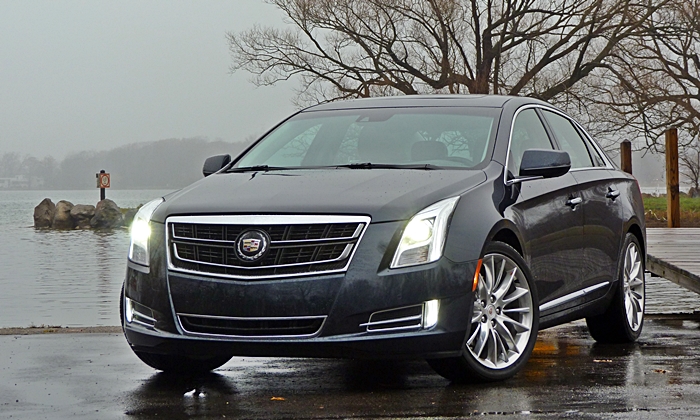
Vertical headlights, highly detailed grille. Couldn't be anything but a Cadillac.
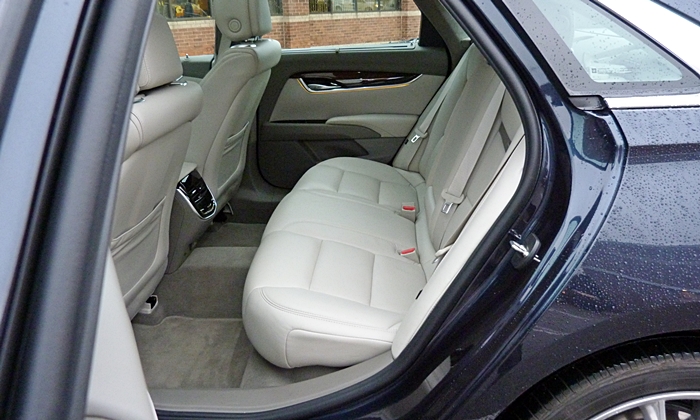
Midsize shoulder room, but abundant legroom.
| Handling |
 Better
Worse
Better
Worse
|
When I first drove a Cadillac XTS, I was pleasantly surprised by how well it handled, with much better composure and balance than I expected from a DTS replacement. When called upon, the XTS will carve corners with aplomb. Get on the gas mid-turn, and the all-wheel-drive system delivers a touch of rear-wheel-drive dynamics. A trace of squishiness can be excised by sliding the shifter into M to activate a sport mode, which firms up the steering and adaptive dampers.
BUT the XTS never stops feeling at least as large and heavy as it is, and the feel of its steering (or the lack of it, even in sport mode) thwarts a connection with the car and impairs rather than inspires confidence. At times a connection seems close, and the car almost seems a willing dance partner, but it's never quite there. Some blame might be due the HiPer Strut front suspension. While this setup eliminates torque steer and enhances the grip of the front tires, it does so at the cost of steering feel.
Also, you won't want to run the XTS in sport mode all the time. The steering, suspension, and drivetrain can't be separately configured as they can in the Audi (all three seperate) and Lincoln (handling and drivetrain separate). Select sport mode in the Cadillac, and the transmission will hold a lower gear, wasting fuel. You can countermand this logic by requesting upshifts with the steering-wheel-mounted shift paddles, but once you do you have to keep using them. Come to a stop then accelerate, and the transmission will hold first until you reach the redline or request an upshift.
Tweaks for the 2013 model year, including the addition of adaptive dampers and torque vectoring, improved the Lincoln's handling. The steering and suspension can be set (together) to one of three modes, though there's less difference between these than in the Cadillac, and far less than in the Audi. Thanks to these tweaks the MKS plows considerably less in hard turns and generally feels less ponderous than it used to. "Clumsy" no longer leaps to mind. Technically it's still not as capable as the Cadillac--push both cars hard along a curvy road or a track (as if), and the somewhat more athletic XTS would leave the MKS behind. But, with more naturally weighted steering, the Lincoln can be a more intuitive car to drive quickly.
In handling more than anywhere else the Audi earns its price premium. When set to "Dynamic" the A8's steering is in a different league, far tighter on-center and quicker to respond than the other two. Virtually nothing upsets the composure of its chassis. Driving the A8 could hardly be more point and shoot.
| |
Compared to the MKS |
| Quietness |
 Better
Worse
Better
Worse
|
Aside from some occasional noise from the 20-inch Bridgestone Potenza tires, the Cadillac XTS rides very quietly. Quietness isn't listed among the reasons to buy an XTS only because you can buy a couple of Chevrolet sedans that are just about as quiet inside. The Malibu and Impala are so good in this area that a Cadillac can't be much better. Also, I had only five slots to work with.
The Lincoln's noise suppression is in the same league aside from a harsher-sounding engine. The Audi, surprisingly, is not. By objective measurements the Audi might be nearly as quiet, but the quality of the noise that manages to intrude, most of it from the road, suggests a less expensive car. For a tomb-like German sedan you'll want a BMW or Mercedes.
| Ride smoothness |
 Better
Worse
Better
Worse
|
Both the Cadillac and Lincoln have traded some (or more than some) of the traditional Detroit plushness for semi-athletic handling. If you're seeking a magic carpet ride, you're out of luck. But if you like a relatively tight, controlled feel and can make some allowance for low-profile tires, both ride well, with a slight edge to the Cadillac. The MKS can get a touch jiggly over minor road imperfections.
The Audi falls down a bit here. In "Dynamic" mode it rides very firmly. Many potential buyers could even find it harsh. But dial the suspension back to "Comfort" and much body control is lost, permitting more low-speed squirm and float than you'll find in either the XTS or MKS. "Normal" strikes a better balance, but not nearly an ideal one. The A8 handles better than it rides.
| Price or payments |
 Better
Worse
Better
Worse
|
An evaluation of the Cadillac XTS Vsport Platinum's $70,020 price could go either way. I ended up in the middle, neither a pro nor a con.
The Lincoln MKS can't be outfitted like the Platinum. Compared to a $67,440 XTS Vsport Premium, the Lincoln lists for $11,695 less. About $2,700 of the difference can be accounted for with the XTS Premium's additional content, leaving a difference of about $8,800. Does the Cadillac seem $8,800 nicer? Yes, yes it does. The Lincoln's interior needs another, more thorough upgrade if it's going to go toe-to-toe with the Cadillac.
As noted in the introduction, the Audi competes in a different league, and is priced accordingly. When similarly equipped it costs over $20,000 more. Worth it? This depends on how much the A8's superior steering and handling, more efficient powertrain, broader interior, and pervasive Germanness are worth to you. $20,000 is a lot of money.
If you don't mind the more tepid acceleration of the non-turbo V6 engine, the regular XTS runs about $5,000 less. You can save even more by opting for the Base or Luxury trim level. The turbocharged engine is only available with the top two trim levels. To get it you must pay for nearly every available feature even if you don't want them.
Or, for the same price as the XTS Vsport Platinum you can get a CTS Vsport Premium (no Platinum trim is offered with the latter). The CTS Vsport is quicker and much more agile--among current midsize luxury sedans it is the most fun to drive. But compared to the XTS it has considerably less space in its rear seat and trunk. And--the deal-killer for some people--it cannot be purchased with all-wheel-drive. Adjust for feature differences, and the smaller, more athletic sedan runs about $5,000 higher.
More than anything else, the Cadillac XTS Platinum warrants its price with dramatic styling and top quality materials. With the twin-turbo V6, acceleration is quick, if not quite as quick as the 410-horsepower rating suggests. Fuel economy isn't so good. The chassis easily outhandles the land yachts of yore, but the steering in particular isn't Audi-class. Ride quality is similarly good but not great. Legroom is plentiful. Shoulder room is not. For the typical large luxury sedan buyer, the largest issue could be the controls, which can be difficult, even frustrating to use. But they sure do look good.
Then there's the price. $70,000 initially seems a lot for a car that shares underpinnings with a $27,000 Chevrolet Impala. But you can't get a similar combination of performance, room, interior materials, and feature content anywhere else for a lower price. The Lincoln MKS is much less money, but looks and feels like a much less expensive car. Meanwhile European competitors cost far more than the Cadillac. If you don't need the full point-and-shoot capability of the Audi, the XTS will seem a better value. Especially if, in line with the Cadillac tradition, you like your styling with a fair amount of drama.
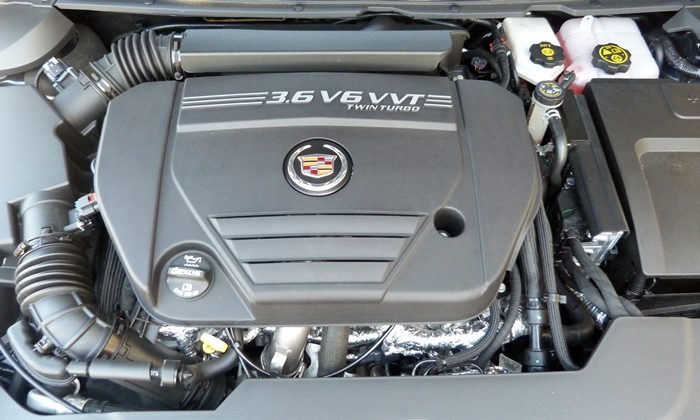
A pair of turbos fixes the low-end torque deficit.
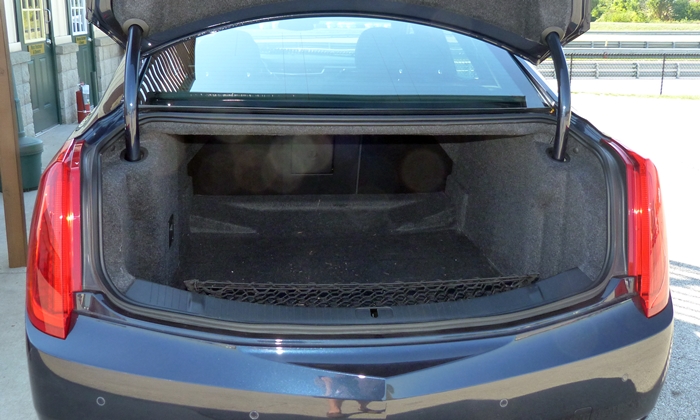
A lot more trunk room than in an Audi, if not quite as much as in the Lincoln MKS.
See more 2014 Cadillac XTS photos
Cadillac provided an insured XTS for four days with a tank of gas. Earlier, Audi provided an A8 for a week. Richard Wolf at Star Lincoln in Southfield, MI, provided an MKS for a test drive. Richard can be reached at 248-354-4900.











